Microbiological and Mycotoxicological Quality of Common Wheat in Romania in the Extremely Dry 2023–2024 Agricultural Year
Abstract
1. Introduction
2. Results and Discussions
2.1. Agrometeorological Conditions in Romania in the Extremely Dry 2023–2024 Agricultural Year
2.2. Microbiological and Mycotoxicological Contamination in Common Wheat in Romania in the Extremely Dry 2023–2024 Agricultural Year
2.2.1. Moisture Content
2.2.2. Water Activity
2.2.3. Total Fungi
2.2.4. Fusarium-Damaged Kernels
2.2.5. Deoxynivalenol Mycotoxin
2.2.6. Total Aflatoxin Mycotoxins
3. Conclusions
4. Materials and Methods
4.1. Agrometeorological Data
4.2. Sampling of Common Wheat
4.3. Analysis of Common Wheat
4.4. Statistical Analysis
- (a)
- Physico-chemical parameters: hectoliter mass (HM, kg/hectolitre), Hagberg falling number (HFN, seconds), protein (P, % dry matter), wet gluten (WG, %), wet gluten deformation index (WGDI, mm), gluten index (GI). Specific equipment was utilized for each determination. The laboratory methods are accredited by the RENAR.
- (b)
- Sensory–colorimetric parameters: L*—sample brightness on a scale from 0 to 100 (L* = 0, black; L* = 100, white); a*—sample color on a scale from pure green to pure red (−a, green; +a, red); and b*—sample color on a scale from pure blue to pure yellow (−b, blue; +b, yellow). Parameters were determined with a CM-5 spectrophotometer (Konica Minolta, Tokyo, Japan). The colorimetric indicators of Romanian wheat fall within the spectrum towards white, red and yellow.
4.5. Geographic Distribution
Supplementary Materials
Author Contributions
Funding
Institutional Review Board Statement
Informed Consent Statement
Data Availability Statement
Acknowledgments
Conflicts of Interest
References
- Acevedo, M.; Zurn, J.D.; Molero, G.; Pawan Singh, P.; He, X.; Aoun, M.; Philomin, J.; Bockleman, H.; Bonman, M.; El-Sohl, M.; et al. The role of wheat in global food security. In Agricultural Development and Sustainable Intensification: Technology and Policy Challenges in the Face of Climate Change; Nagothu, U.S., Ed.; Routledge: London, UK, 2018; pp. 81–110. [Google Scholar] [CrossRef]
- Food and Agriculture Organization of the United Nations (FAO). Production Quantities of Wheat by Country, Average 1961–2023. Crops and Livestock Products. Rome, Italy. 2025. Available online: https://www.fao.org/faostat/en/#data/QCL/visualize (accessed on 17 January 2025).
- Khan, A.; Ahmad, M.; Ahmed, M.; Iftikhar Hussain, M. Rising Atmospheric Temperature Impact on Wheat and Thermotolerance Strategies. Plants 2021, 10, 43. [Google Scholar] [CrossRef] [PubMed]
- Zahra, N.; Hafeez, M.B.; Wahid, A.; Al Masruri, M.H.; Ullah, A.; Siddique, K.H.M.; Farooq, M. Impact of climate change on wheat grain composition and quality. J. Sci. Food Agric. 2023, 103, 2745–2751. [Google Scholar] [CrossRef]
- Battilani, P.; Toscano, P.; Van Der Fels-Klerx, H.J.; Moretti, A.; Camardo Leggieri, M.; Brera, C.; Rortais, A.; Goumperis, T.; Robinson, T. Aflatoxin B1 contamination in maize in Europe increases due to climate change. Sci. Rep. 2016, 6, 24328. [Google Scholar] [CrossRef] [PubMed]
- Gagiu, V.; Mateescu, E.; Armeanu, I.; Dobre, A.A.; Smeu, I.; Cucu, M.E.; Oprea, O.A.; Iorga, E.; Belc, N. Post-Harvest Contamination with Mycotoxins in the Context of the Geographic and Agroclimatic Conditions in Romania. Toxins 2018, 10, 533. [Google Scholar] [CrossRef]
- Gagiu, V.; Mateescu, E.; Dobre, A.A.; Smeu, I.; Cucu, M.E.; Oprea, O.A.; Alexandru, D.; Iorga, E.; Belc, N. Deoxynivalenol occurrence in triticale crops in Romania during the 2012–2014 period with extreme weather events. Toxins 2021, 13, 456. [Google Scholar] [CrossRef] [PubMed]
- Gagiu, V.; Mateescu, E.; Belc, N.; Oprea, O.-A.; Pîrvu, G.-P. Assessment of Fusarium-damaged kernels in common wheat in Romania in the years 2015 and 2016 with extreme weather events. Toxins 2022, 14, 326. [Google Scholar] [CrossRef]
- Gagiu, V.; Mexi, I.; Oprea, O.A.; Cucu, M.E.; Dobre, A.A.; Mateescu, E.; Belc, N. Total aflatoxin contamination in common wheat in Romania in the years 2015 and 2016 with extreme weather events. J. Hyg. Eng. Des. 2023, 45, 28–39. [Google Scholar]
- Gagiu, V.; Ungureanu, E.L.; Borda, D.; Mustățea, G.; Mateescu, E.; Belc, N. Deoxynivalenol and heavy metals contamination in common wheat in Romania in the extremely dry year 2015. J. Hyg. Eng. Des. 2023, 45, 134–150. [Google Scholar]
- Zingales, V.; Taroncher, M.; Martino, P.A.; Ruiz, M.-J.; Caloni, F. Climate Change and Effects on Molds and Mycotoxins. Toxins 2022, 14, 445. [Google Scholar] [CrossRef]
- Chen, J.; Sharifi, R.; Khan, M.S.S.; Islam, F.; Bhat, J.A.; Kui, L.; Majeed, A. Wheat Microbiome: Structure, Dynamics, and Role in Improving Performance Under Stress Environments. Front. Microbiol. 2022, 12, 821546. [Google Scholar] [CrossRef]
- Kos, J.; Anić, M.; Radić, B.; Zadravec, M.; Janić Hajnal, E.; Pleadin, J. Climate Change—A Global Threat Resulting in Increasing Mycotoxin Occurrence. Foods 2023, 12, 2704. [Google Scholar] [CrossRef] [PubMed]
- Khan, R. Mycotoxins in food: Occurrence, health implications, and control strategies—A comprehensive review. Toxicon 2024, 248, 108038. [Google Scholar] [CrossRef] [PubMed]
- Copernicus Climate Change Service (C3S). The 2024 Annual Climate Summary Global Climate Highlights 2024. Published on 10th January 2025. Available online: https://climate.copernicus.eu/global-climate-highlights-2024?form=MG0AV3 (accessed on 14 January 2025).
- Copernicus Climate Change Service (C3S). Copernicus: Summer 2024–Hottest on Record Globally and for Europe. Published on 6th September 2024. Available online: https://climate.copernicus.eu/copernicus-summer-2024-hottest-record-globally-and-europe (accessed on 13 January 2025).
- Korosec, M. The First Significant Heatwave of Summer 2024 Is Forecast to Spread Across a Large Part of Europe. Published on 15 June 2024. Available online: https://www.severe-weather.eu/global-weather/first-significant-heatwave-summer-2024-forecast-europe-mk/ (accessed on 14 January 2025).
- Met Office UK. Verification of Experimental Seasonal Summary Forecast for UK Area, June-July-August 2024. Available online: https://www.weather-info.co.uk/wxsvc/VerifJJA2024.html (accessed on 5 February 2025).
- Biavetti, I.; Bussay, A.; Cerrani, I.; Claverie, M.; De Palma, P.; Fumagalli, D.; Henin, R.; Luque Reyes, J.; Manfron, G.; Morel, J.; et al. JRC MARS Bulletin-Crop Monitoring in Europe; Niemeyer, S., Vandenberg, M., Eds.; Publications Office of the European Union: Luxembourg, 2024; Volume 32. [Google Scholar] [CrossRef]
- European Drought Observatory (EDO). Current Drought Situation in Europe. The Latest Status of Drought in Europe Using a Combined Drought Indicator. European Commission. 2024. Available online: https://joint-research-centre.ec.europa.eu/european-and-global-drought-observatories/current-drought-situation-europe_en (accessed on 14 January 2025).
- European Commission (EC). Commission Approves €400 Million Romanian State Aid Scheme to Compensate Farmers Affected by Severe Drought. Daily News, 24 October 2024. Available online: https://ec.europa.eu/commission/presscorner/detail/en/mex_24_5463 (accessed on 20 January 2025).
- Guvernul României. EMERGENCY ORDINANCE no. 120 of 9 October 2024 Regarding the Establishment of a State aid Scheme in the Form of a Grant to Agricultural Producers for Agricultural Crops Affected by the Pedological Drought from September 2023 to August 2024. Publicat in MONITORUL OFICIAL nr. 1034 Din 15 Octombrie 2024. Available online: https://legislatie.just.ro/Public/DetaliiDocument/289748 (accessed on 30 January 2025). (In Romanian).
- Administratia Nationala de Meteorologie (Meteo-Romania). Agrometeorological Characterization 1 September 2023–31 August 2024. Agrometeorological Service of the National Meteorological Administration. 2024. Available online: https://www.meteoromania.ro/wp-content/uploads/comunicate/Caracterizare-agrometeorologica-2023-2024.pdf (accessed on 20 November 2024). (In Romanian).
- Ministerul Agriculturii și Dezvoltării Rurale (MADR). MANUAL of 5 July 2017 Grading for Consumer Seeds. Publicat în Monitorul Oficial nr. 537 bis Din 10 Iulie 2017. Available online: http://legislatie.just.ro/Public/DetaliiDocumentAfis/192063 (accessed on 29 January 2025). (In Romanian).
- Paltineanu, C.; Mihailescu, I.F.; Seceleanu, I.; Dragota, C.; Vasenciuc, F. Using aridity indices to describe some climate and soil features in Eastern Europe: A Romanian case study. Theor. Appl. Climatol. 2007, 90, 263–274. [Google Scholar] [CrossRef]
- Al-Mahasneh, M.A.; Rababah, T.M. Effect of moisture content on some physical properties of green wheat. J. Food Eng. 2007, 79, 1467–1473. [Google Scholar] [CrossRef]
- Karimi, M.; Kheiralipour, K.; Tabatabaeefar, A.; Khoubakht, G.M.; Naderi, M.; Heidarbeigi, K. The Effect of Moisture Content on Physical Properties of Wheat. Pak. J. Nutr. 2009, 8, 90–95. [Google Scholar] [CrossRef]
- Yousefian, M.; Shahbazi, F.; Hamidian, K. Crop Yield and Physicochemical Properties of Wheat Grains as Affected by Tillage Systems. Sustainability 2021, 13, 4781. [Google Scholar] [CrossRef]
- Domian, E.; Poszytek, K. Wheat flour flowability as affected by water activity, storage time and consolidation. Int. Agrophys. 2005, 19, 119–124. [Google Scholar]
- Mannaa, M.; Kim, K.D. Influence of Temperature and Water Activity on Deleterious Fungi and Mycotoxin Production during Grain Storage. Mycobiology 2017, 45, 240–254. [Google Scholar] [CrossRef]
- Beuchat, L.R. Influence of Water Activity on Growth, Metabolic Activities and Survival of Yeasts and Molds. J. Food Prot. 1983, 46, 135–141. [Google Scholar] [CrossRef]
- Comerio, R.M.; Fernández Pinto, V.E.; Vaamonde, G. Influence of water activity on deoxynivalenol accumulation in wheat. Mycotoxin Res. 1999, 15, 24–32. [Google Scholar] [CrossRef]
- Hassane, A.M.A.; El-Shanawany, A.A.; Abo-Dahab, N.F.; Abdel-Hadi, A.M.; Abdul-Raouf, U.M.; Mwanza, M. Influence of Different Moisture Contents and Temperature on Growth and Production of Aflatoxin B1 by a Toxigenic Aspergillus flavus Isolate in Wheat Flour. J. Ecol. Health Environ. 2017, 5, 77–83. [Google Scholar] [CrossRef]
- Nasiri, M.; Mosaddeghi, M.R.; Majidi, M.M.; Zarebanadkouki, M. Exploring soil-root interactions: A comparative study of wheat species and soil types. Environ. Exp. Bot. 2024, 220, 105710. [Google Scholar] [CrossRef]
- Lehari, K.; Kumar, M.; Burman, V.; Vaishali, A.; Kumar, V.; Chand, P.; Singh, R. Morphological, physiological and biochemical analysis of wheat genotypes under drought stress. J. Pharmacogn. Phytochem. 2019, 8, 1026–1030. [Google Scholar]
- Nyaupane, S.; Poudel, M.R.; Panthi, B.; Dhakal, A.; Paudel, H.; Bhandari, R. Drought stress effect, tolerance, and management in wheat—A review. Cogent Food Agric. 2024, 10, 2296094. [Google Scholar] [CrossRef]
- Kochiieru, Y.; Mankevičienė, A.; Cesevičienė, J.; Semaškienė, R.; Ramanauskienė, J.; Gorash, A.; Janavičienė, S.; Venslovas, E. The Impact of Harvesting Time on Fusarium Mycotoxins in Spring Wheat Grain and Their Interaction with Grain Quality. Agronomy 2021, 11, 642. [Google Scholar] [CrossRef]
- Juarez-Enriquez, E.; Olivas, G.I.; Ortega-Rivas, E.; Zamudio-Flores, P.B.; Perez-Vega, S.; Sepulveda, D.R. Water activity, not moisture content, explains the influence of water on powder flowability. LWT-Food Sci. Technol. 2019, 100, 35–39. [Google Scholar] [CrossRef]
- Gulino, D.; Lopes, M.S. Phenological Adaptation of Wheat Varieties to Rising Temperatures: Implications for Yield Components and Grain Quality. Plants 2024, 13, 2929. [Google Scholar] [CrossRef] [PubMed]
- Marynin, A.; Pasichny, V.; Litvynchuk, S.; Khomichak, L.; Kuznietsova, I.; Vysotska, S. Influence of water activity on the properties of wheat flour. Ukr. Food J. 2021, 10, 375–386. [Google Scholar] [CrossRef]
- Clawson, A.R.; Taylor, A.J. Chemical changes during cooking of wheat. Food Chem. 1993, 47, 337–343. [Google Scholar] [CrossRef]
- Lukow, O.M.; Kathy, A.; Jerry, S.; De Pauw, R.M.; Humphreys, G. The effect of the environment on the grain colour and quality of commercially grown Canada hard white spring wheat, Triticum aestivum L. ‘Snowbird’. Can. J. Plant Sci. 2013, 93, 1–11. [Google Scholar] [CrossRef]
- Eskola, M.; Kos, G.; Elliott, C.T.; Hajlová, J.; Mayar, S.; Krska, R. Worldwide contamination of food-crops with mycotoxins: Validity of the widely cited ‘FAO estimate’ of 25. Crit. Rev. Food Sci. Nutr. 2020, 60, 2773–2789. [Google Scholar] [CrossRef] [PubMed]
- Treseder, K.K.; Berlemont, R.; Allison, S.D.; Martiny, A.C. Drought increases the frequencies of fungal functional genes related to carbon and nitrogen acquisition. PLoS ONE 2018, 13, e0206441. [Google Scholar] [CrossRef]
- Autoritatea Națională Sanitară-Veterinară (ANSVSA). ORDER no. 249 of March 31, 2003 for the Approval of the Norms on Quality and Sanitation Parameters for the Production, Import, Quality Control, Marketing and Use of Simple and Combined Concentrated Feeds, Feed Additives, Premixes, Energy Substances, Mineral Substances and Special Feeds. Autoritatea Națională Sanitară-Veterinară, București, 2023. Emitenți: Ministerul Agriculturii, Alimentației și Pădurilor nr. 249 Din 31 Martie 2003 și Ministerul Sănătății nr. 358 Din 15 Aprilie 2003. Publicat în: MONITORUL OFICIAL nr. 362 Din 28 Mai 2003. Available online: https://legislatie.just.ro/Public/DetaliiDocumentAfis/43985 (accessed on 20 November 2024). (In Romanian).
- Autoritatea Naţională Sanitară Veterinară şi pentru Siguranţa Alimentelor (ANSVSA). ORDER No. 27 of June 6, 2011 Regarding the Approval of the Microbiological and Hygiene Criteria That Apply to Food Products, Other than Those Mentioned in Regulation (EC) no. 2.073/2005 of the Commission of November 15, 2005 Regarding the Microbiological Criteria for Food Products. Publicat în: Monitorul Oficial nr. 435 Din 22 Iunie 2011. Available online: https://legislatie.just.ro/Public/DetaliiDocumentAfis/129504 (accessed on 4 February 2025). (In Romanian).
- Furtak, K.; Grządziel, J.; Gałązka, A.; Gawryjołek, K.; Niedźwiecki, J. Fungal biodiversity and metabolic potential of selected fluvisols from the Vistula River valley in Lubelskie, Poland. Appl. Soil Ecol. 2021, 160, 103866. [Google Scholar] [CrossRef]
- Siebielec, S.; Siebielec, G.; Klimkowicz-Pawlas, A.; Gałązka, A.; Grządziel, J.; Stuczyński, T. Impact of Water Stress on Microbial Community and Activity in Sandy and Loamy Soils. Agronomy 2020, 10, 1429. [Google Scholar] [CrossRef]
- Lozano, Y.M.; Aguilar-Trigueros, C.A.; Roy, J.; Rillig, M.C. Drought induces shifts in soil fungal communities that can be linked to root traits across 24 plant species. New Phytopathol. 2021, 232, 1917–1929. [Google Scholar] [CrossRef] [PubMed]
- Gooding, M.J.; Ellis, R.H.; Shewry, P.R.; Schofield, J.D. Effects of Restricted Water Availability and Increased Temperature on the Grain Filling, Drying and Quality of Winter Wheat. J. Cereal Sci. 2003, 37, 295–309. [Google Scholar] [CrossRef]
- Bodor, Z.; Bodor, K.; Keresztesi, Á.; Szép, R. Major air pollutants seasonal variation analysis and long-range transport of PM10 in an urban environment with specific climate condition in Transylvania (Romania). Environ. Sci. Pollut. Res. 2020, 27, 38181–38199. [Google Scholar] [CrossRef]
- Song, Y.; Linderholm, H.W.; Wang, C.; Tian, J.; Huo, Z.; Gao, P.; Song, Y.; Guo, A. The influence of excess precipitation on winter wheat under climate change in China from 1961 to 2017. Sci. Total Environ. 2019, 690, 189–196. [Google Scholar] [CrossRef]
- Del Ponte, E.M.; Fernandes, J.M.C.; Bergstrom, G.C. Influence of Growth Stage on Fusarium Head Blight and Deoxynivalenol Production in Wheat. J. Phytopathol. 2007, 155, 577–581. [Google Scholar] [CrossRef]
- Peršić, V.; Božinović, I.; Varnica, I.; Babić, J.; Španić, V. Impact of Fusarium Head Blight on Wheat Flour Quality: Examination of Protease Activity, Technological Quality and Rheological Properties. Agronomy 2023, 13, 662. [Google Scholar] [CrossRef]
- Bellesi, F.J.; Arata, A.F.; Martínez, M.; Arrigoni, A.C.; Stenglein, S.A.; Dinolfo, M.I. Degradation of gluten proteins by Fusarium species and their impact on the grain quality of bread wheat. J. Stored Prod. Res. 2019, 83, 1–8. [Google Scholar] [CrossRef]
- Keler, V.V.; Martynova, O.V. Variation of gluten amount in wheat grain under the influence of weather conditions. IOP Conf. Ser. Earth Environ. Sci. 2020, 548, 052014. [Google Scholar] [CrossRef]
- European Commission (EC). COMMISSION REGULATION (EU) 2024/1022 of 8 April 2024 Amending Regulation (EU) 2023/915 as Regards Maximum Levels of Deoxynivalenol in Food (Text with EEA Relevance). EUR-Lex. 2024. Available online: https://eur-lex.europa.eu/legal-content/EN/TXT/?uri=OJ%3AL_202401022 (accessed on 22 November 2024).
- Ackerman, A.J.; Holmes, R.; Gaskins, E.; Jordan, K.E.; Hicks, D.S.; Fitzgerald, J.; Griffey, C.A.; Mason, R.E.; Harrison, S.A.; Murphy, J.P.; et al. Evaluation of Methods for Measuring Fusarium-Damaged Kernels of Wheat. Agronomy 2022, 12, 532. [Google Scholar] [CrossRef]
- Gyuricza, C.; Balla, I.; Tarnawa, Á.; Nyárai, F.H.; Kassai, K.; Szentpétery, Z.; Jolánkai, M. Impact of precipitation on yield quantity and quality of wheat and maize crops. Időjárás 2012, 116, 211–220. [Google Scholar]
- van der Fels-Klerx, H.J.; Olesen, J.E.; Madsen, M.S.; Goedhart, P.W. Climate change increases deoxynivalenol contamination of wheat in north-western Europe. Food Addit. Contam. Part A 2012, 29, 1593–1604. [Google Scholar] [CrossRef] [PubMed]
- Gagkaeva, T.; Gavrilova, O.; Orina, A.; Lebedin, Y.; Shanin, I.; Petukhov, P.; Eremin, S. Analysis of Toxigenic Fusarium Species Associated with Wheat Grain from Three Regions of Russia: Volga, Ural, and West Siberia. Toxins 2019, 11, 252. [Google Scholar] [CrossRef]
- European Commission (EC). Commission Regulation (EU) 2023/915 of 25 April 2023 on Maximum Levels for Certain Contaminants in Food and Repealing Regulation (EC) No 1881/2006 (Text with EEA Relevance). EUR-Lex. 2023. Available online: https://eur-lex.europa.eu/legal-content/EN/TXT/?uri=CELEX:32023R0915 (accessed on 20 January 2025).
- Ostry, V.; Malir, F.; Toman, J.; Grosse, Y. Mycotoxins as human carcinogens—The IARC Monographs classification. Mycotoxin Res. 2017, 33, 65–73. [Google Scholar] [CrossRef]
- International Agency for Research on Cancer (IARC). Agents Classified by the IARC Monographs, Vol. 1–133. Last Update: 24 March 2023. Available online: https://monographs.iarc.who.int/agents-classified-by-the-iarc/ (accessed on 20 January 2025).
- Gizachew, D.; Chang, C.-H.; Szonyi, B.; De La Torre, S.; Evert Ting, W.E. Aflatoxin B1 (AFB1) production by Aspergillus flavus and Aspergillus parasiticus on ground Nyjer seeds: The effect of water activity and temperature. Int. J. Food Microbiol. 2019, 296, 8–13. [Google Scholar] [CrossRef]
- Farkas, Z.; Országh, E.; Engelhardt, T.; Csorba, S.; Kerekes, K.; Zentai, A.; Süth, M.; Nagy, A.; Miklós, G.; Molnár, K.; et al. A Systematic Review of the Efficacy of Interventions to Control Aflatoxins in the Dairy Production Chain—Feed Production and Animal Feeding Interventions. Toxins 2022, 14, 115. [Google Scholar] [CrossRef]
- Accinelli, C.; Abbas, H.K.; Zablotowicz, R.M.; Wilkinson, J.R. Aspergillus flavus aflatoxin occurrence and expression of aflatoxin biosynthesis genes in soil. Can. J. Microbiol. 2008, 54, 371–379. [Google Scholar] [CrossRef]
- Man, S.; Tofana, M.; Muste, S.; Paucea, A.; Birou (Pop), A. Natural Occurrence of Aflatoxins in Wheat from Central Transylvania. Bull. Univ. Agric. Sci. Vet. Med. Cluj-Napoca. Agric. 2011, 6, 311–316. [Google Scholar] [CrossRef]
- Alexa, E.; Dehelean, C.A.; Poiana, M.A.; Radulov, I.; Cimpean, A.-M.; Bordean, D.-M.; Tulcan, C.; Pop, G. The occurrence of mycotoxins in wheat from western Romania and histopathological impact as effect of feed intake. Chem. Cent. J. 2013, 7, 99. [Google Scholar] [CrossRef] [PubMed]
- Stanciu, O.; Juan, C.; Miere, D.; Loghin, F.; Mañes, J. Occurrence and co-occurrence of Fusarium mycotoxins in wheat grains and wheat flour from Romania. Food Control 2017, 73 Pt B, 147–155. [Google Scholar] [CrossRef]
- Lin, H.; Wang, F.; Duan, Y.; Kang, W.; Chen, Q.; Xue, Z. Early detection of wheat Aspergillus infection based on nanocomposite colorimetric sensor and multivariable models. Sens. Actuators B Chem. 2022, 351, 130910. [Google Scholar] [CrossRef]
- Alltech Harvest Analysis. The 2024 Mycotoxin Landscape: Insights from North America, Canada and Europe. Published on 18 November 2024. Available online: https://www.feednavigator.com/News/Promotional-features/2024-harvest-insights-mapping-mycotoxin-risk/ (accessed on 1 February 2025).
- Lefter, A. Tens of Thousands of Tons of Romanian Corn Were Rejected for Export. Agrointeligența, Published on 28 October 2024. Available online: https://agrointel.ro/310311/zeci-de-mii-de-tone-de-porumb-romanesc-au-fost-respinse-la-export (accessed on 17 February 2025). (In Romanian).
- Battilani, P.; Rossi, V.; Giorni, P.; Pietri, A.; Gualla, A.; van der Fels-Klerx, H.J.; Booij, C.J.H.; Moretti, A.; Logrieco, A.; Miglietta, F.; et al. Modelling, predicting and mapping the emergence of aflatoxins in cereals in the EU due to climate change. EFSA Support. Publ. 2012, 9, 223E. [Google Scholar] [CrossRef]
- Grillakis, M.G. Increase in severe and extreme soil moisture droughts for Europe under climate change. Sci. Total Environ. 2019, 660, 1245–1255. [Google Scholar] [CrossRef]
- Pradhan, P.; Seydewitz, T.; Zhou, B.; Lüdeke, M.K.B.; Kropp, J.P. Climate Extremes are Becoming More Frequent, Co-occurring, and Persistent in Europe. Anthr. Sci. 2022, 1, 264–277. [Google Scholar] [CrossRef]
- SR EN ISO/IEC 17025:2018; General Requirements for the Competence of Testing and Calibration Laboratories. ASRO: Bucharest, Romania, 2018.
- Standard SR EN ISO 712:2010; Cereals and Cereal Products—Determination of Moisture Content—Reference Method. ASRO: Bucharest, Romania, 2010.
- Standard SR ISO 21527-2/2009; Microbiology of Food and Animal Feeding Stuffs—Horizontal Method for the Enumeration of Yeasts and Molds. Part 2: Colony Count Technique in Products with Water Activity Less than or Equal to 0.95. ASRO: Bucharest, Romania, 2009.
- Standard SR EN ISO 7970:2011; Wheat (Triticum aestivum L.). Specifications. ASRO: Bucharest, Romania, 2011.

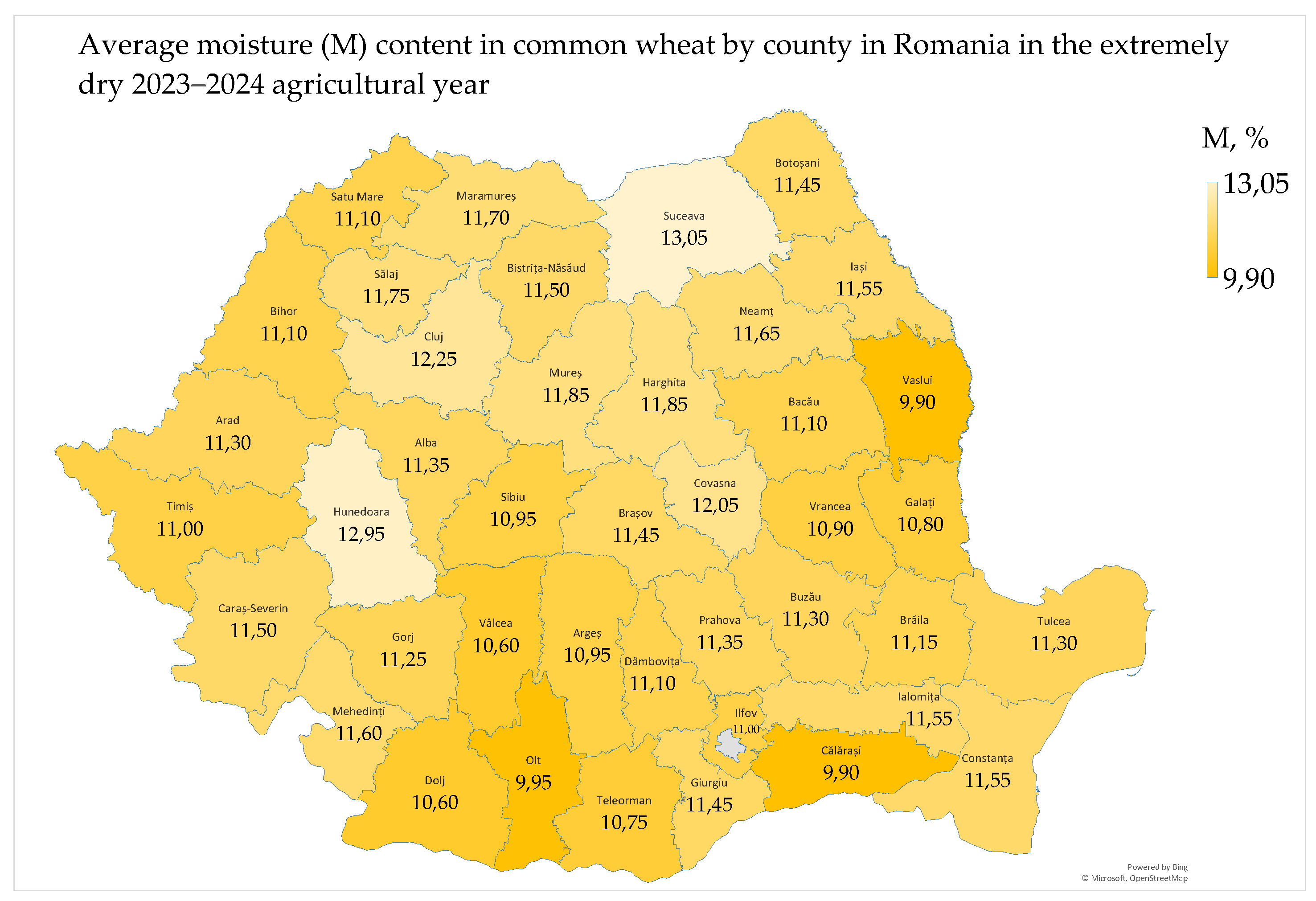
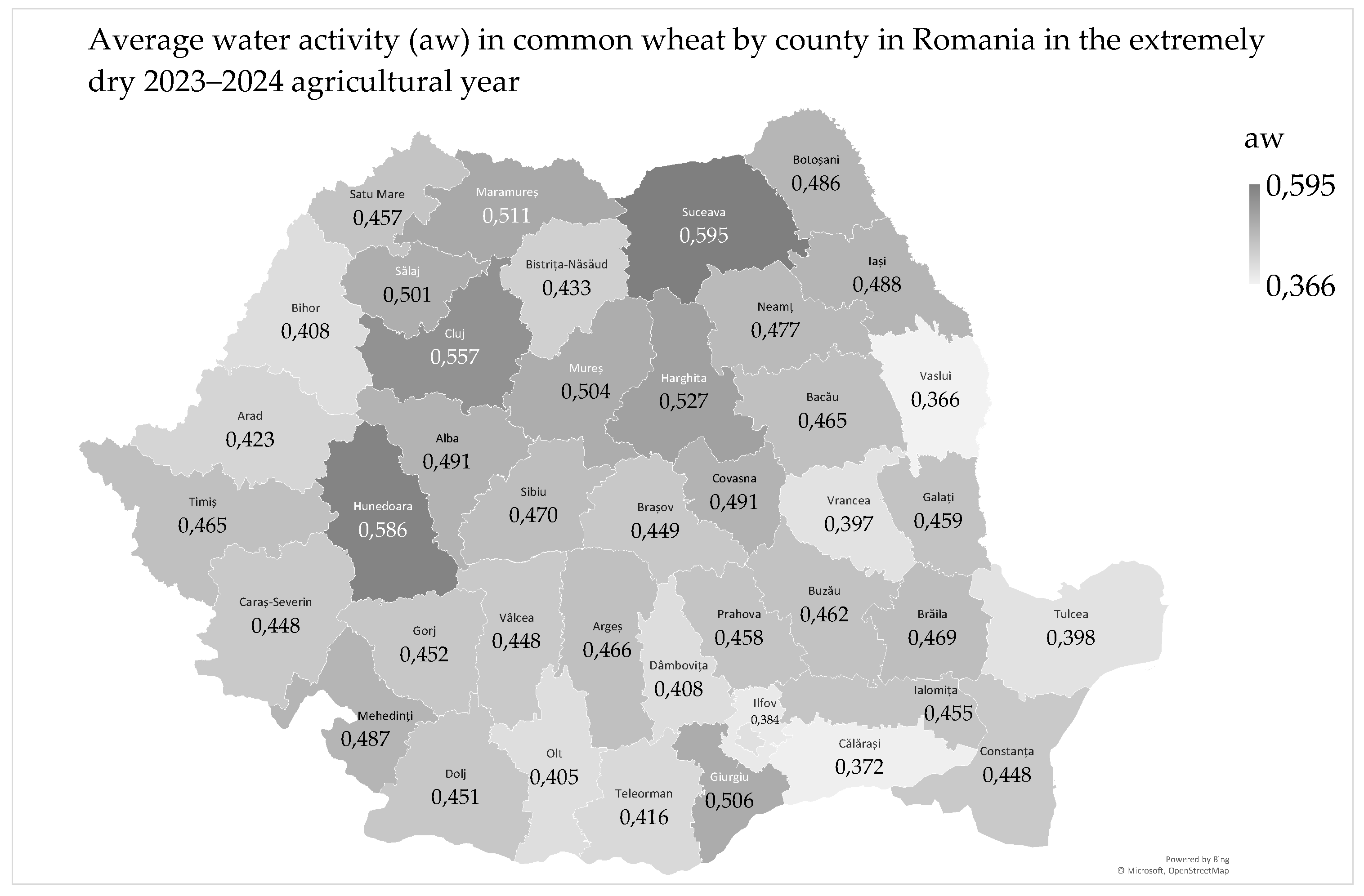

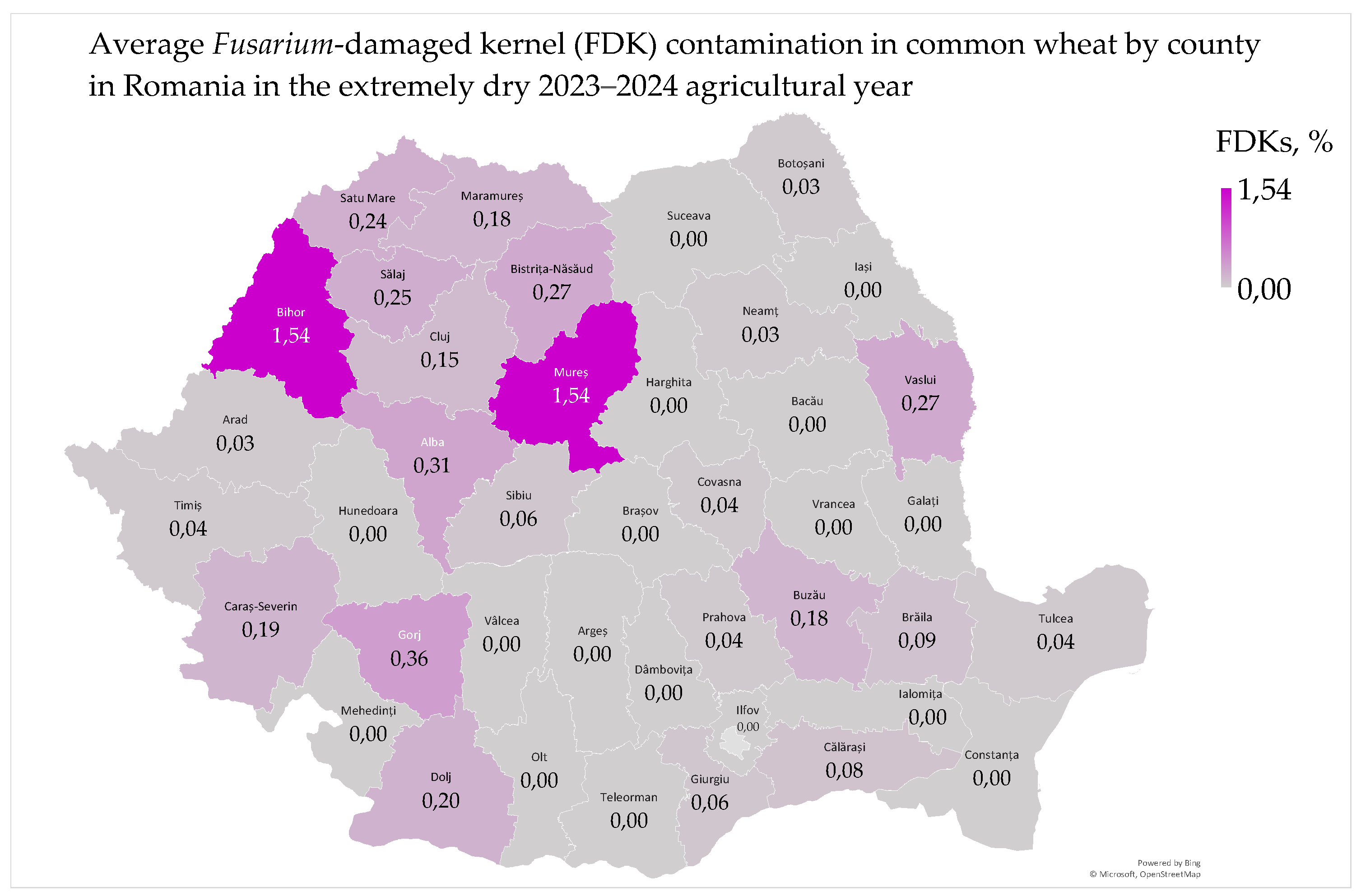
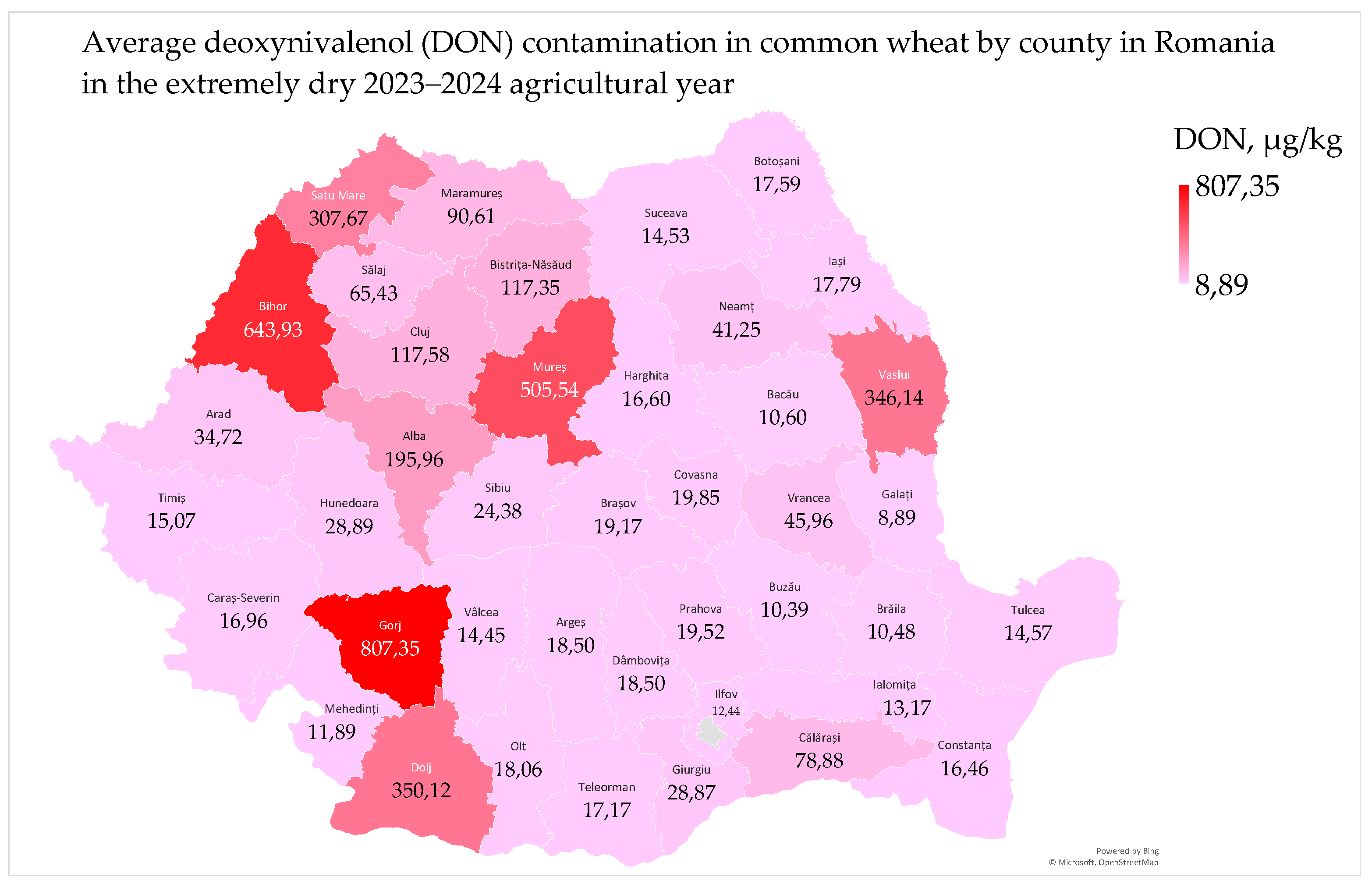
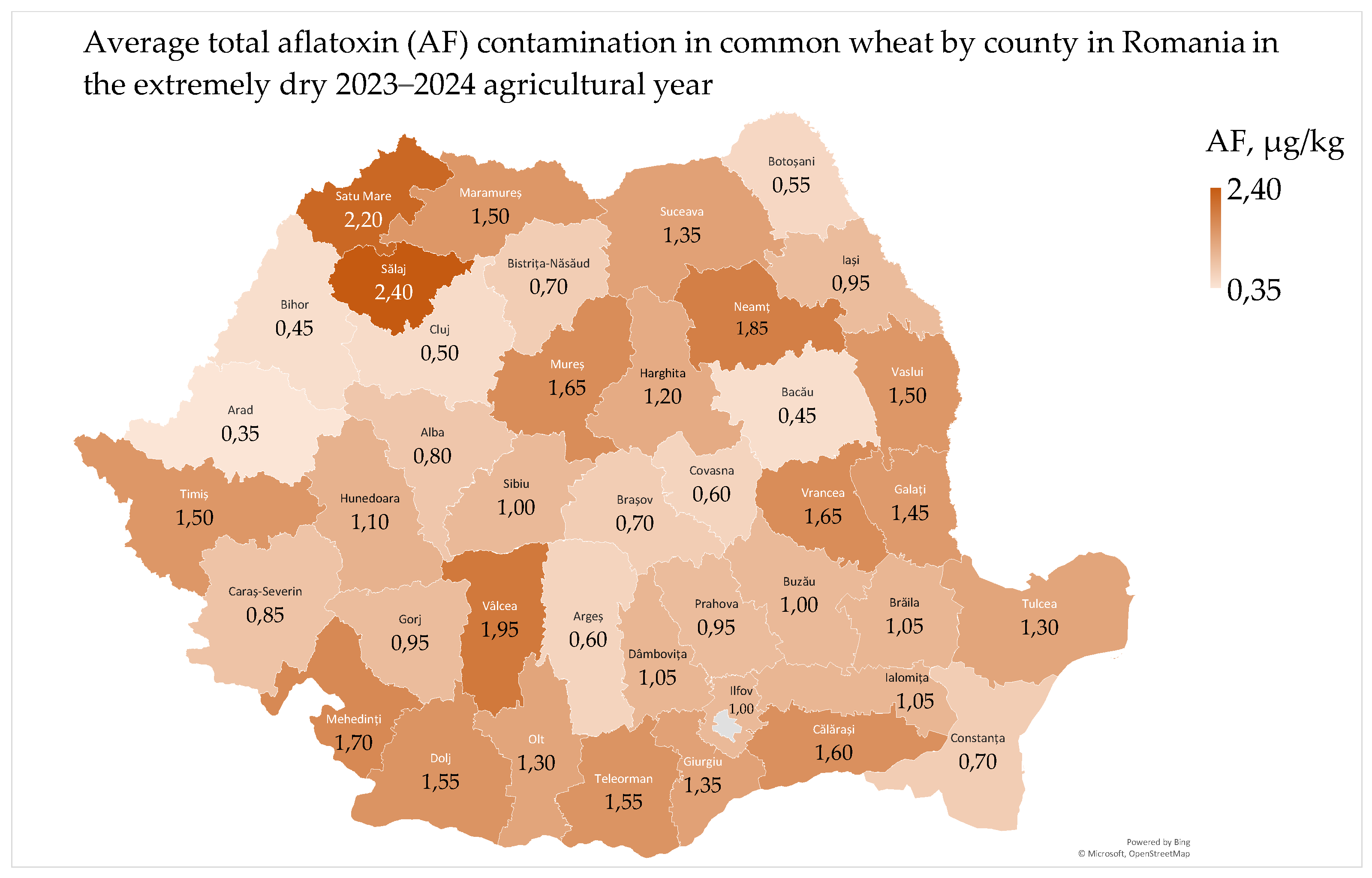

Disclaimer/Publisher’s Note: The statements, opinions and data contained in all publications are solely those of the individual author(s) and contributor(s) and not of MDPI and/or the editor(s). MDPI and/or the editor(s) disclaim responsibility for any injury to people or property resulting from any ideas, methods, instructions or products referred to in the content. |
© 2025 by the authors. Licensee MDPI, Basel, Switzerland. This article is an open access article distributed under the terms and conditions of the Creative Commons Attribution (CC BY) license (https://creativecommons.org/licenses/by/4.0/).
Share and Cite
Gagiu, V.; Cucu, E.M.; Dobre, A.A.; Pirvu, G.P.; Oprea, O.A.; Pomohaci, C.M.; Mateescu, E.; Belc, N.; Marin, D.I. Microbiological and Mycotoxicological Quality of Common Wheat in Romania in the Extremely Dry 2023–2024 Agricultural Year. Toxins 2025, 17, 154. https://doi.org/10.3390/toxins17040154
Gagiu V, Cucu EM, Dobre AA, Pirvu GP, Oprea OA, Pomohaci CM, Mateescu E, Belc N, Marin DI. Microbiological and Mycotoxicological Quality of Common Wheat in Romania in the Extremely Dry 2023–2024 Agricultural Year. Toxins. 2025; 17(4):154. https://doi.org/10.3390/toxins17040154
Chicago/Turabian StyleGagiu, Valeria, Elena Mirela Cucu, Alina Alexandra Dobre, Gina Pusa Pirvu, Oana Alexandra Oprea, Cristian Mihai Pomohaci, Elena Mateescu, Nastasia Belc, and Doru Ioan Marin. 2025. "Microbiological and Mycotoxicological Quality of Common Wheat in Romania in the Extremely Dry 2023–2024 Agricultural Year" Toxins 17, no. 4: 154. https://doi.org/10.3390/toxins17040154
APA StyleGagiu, V., Cucu, E. M., Dobre, A. A., Pirvu, G. P., Oprea, O. A., Pomohaci, C. M., Mateescu, E., Belc, N., & Marin, D. I. (2025). Microbiological and Mycotoxicological Quality of Common Wheat in Romania in the Extremely Dry 2023–2024 Agricultural Year. Toxins, 17(4), 154. https://doi.org/10.3390/toxins17040154





